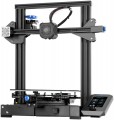Compatible software
Software for building models which the printer is optimally compatible with. The software used for 3D printing includes both CAD (automatic design systems for creating models) and slicers (software that break a three-dimensional model into separate layers, preparing it for printing). Therefore, this paragraph often indicates a whole list of software products.
Note that the degree of optimization in this case may be different: some models are compatible only with the claimed programs, but many printers are able to work with third-party CAD systems. However, it is best to choose software directly claimed by the manufacturer: this will maximize the capabilities of the printer and minimize the chance of failures and “inconsistencies” during operation.
Heating bed temperature
Maximum heating temperature in 3D printers with heated bed (for more details, see the relevant paragraph). The higher the limit, the more varieties of plastic can be used for printing. So, models with heating up to 100 °C are suitable for 3D printing with PLA plastic, with a bed temperature of 100 to 120 °C — for working with ABS plastic and nylon, high-temperature ones — allow the use of polycarbonate and refractory varieties of plastic.
Extruder (nozzle) temperature
The heating temperature provided by the extruder in an FDM/FFF or PJP printer (see Printing Technology) .
Compatibility with this or that printed material directly depends on this parameter. For example, for PLA plastic, temperature range 180 – 230 °C is required, for ABS it will require 220 – 250 °C, and for polycarbonate — at least 270 °C. The temperature definitely should not be too low — otherwise the material simply cannot melt normally. But the margin in most cases is quite acceptable — for example, many PLA-compatible models operate at temperatures of about 250 °C, or even 280 °C.
Thus, a higher operating temperature enhances the printer's capabilities and its compatibility with various types of thermoplastics. On the other hand, the more the material is heated, the worse it cools down; to ensure sufficient solidification efficiency, one must either reduce the printing speed (which increases the time required) or increase the blowing intensity (which affects the cost). Well, anyway, while choosing, you should focus primarily on filaments, which compatibility is directly indicated in the specs.
Stepper motor driver
Drivers are small chips that control the drives in 3D printers. Essentially, they control the flow of current to the stepper motor. Drivers from Trinamic Motion Control are widely used. Thus, the TMC2208 and TMC2209, as well as their improved modification TMC2225, are rightfully considered very quiet options. These drivers support step division up to 1:256 and can function either independently with manual changes or in UART mode, in which the motor current is adjusted via firmware.
LCD display
The printer has its own screen. The specific functionality of such a screen can be different - from the simplest indicator for several characters and service symbols to a full-fledged color matrix capable of displaying inscriptions, drawings, etc.; These nuances should be clarified separately. However, in any case, this feature provides additional ease of management: various service information can be displayed on the screen to help the user set up printing parameters and control the process.
We would like to emphasize that touch displays are not included in this category; they are indicated as a separate function. But the screen size directly affects the comfort when working with the device.
There are also models with a touch screen, similar to those used in smartphones and tablets. Such a display is a full-fledged control tool, and it is more convenient and functional than more traditional options such as keypads: you can display a wide variety of control elements (buttons, sliders, lists, etc.) on the screen, selecting the optimal set of these elements for your needs. specific situation. In addition, the screen itself usually has a color matrix with a fairly high resolution, which makes it possible to display a wide variety of service data - even drawings and diagrams. Thanks to all this, most printer control functions can be performed through such a display; some models with such equipment are able to work even without connecting to a computer. The disad...vantages of touch displays include their higher cost than conventional ones, despite the fact that control via a computer is usually still more practical and visual. So this function is relatively rare these days.
Power
Rated input power of the printer, in fact — the highest power consumed by the device in regular operation.
This indicator is directly related to the specs of the device, primarily the overall performance. However, generally, 3D printers are a relatively economical devices: among solutions that are not related to specialized industrial equipment, values of more than 1 kW are extremely rare, and even in the most performant models this figure does not exceed 3 kW. For such capacities, an ordinary household power outlet is quite enough, so you have to pay attention to power consumption mainly in specific cases — for example, when assessing the load on a voltage stabilizer or a backup power source.

